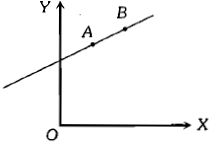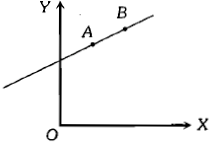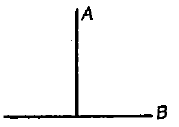A small disc of radius 2 cm is cut from a disc of radius 6 cm. If the distance between their centres is 3.2 cm, what is the shift in the centre of mass of the disc?
1. 0.4 cm
2. 2.4 cm
3. 1.8 cm
4. 1.2 cm
6 cm त्रिज्या की डिस्क से 2 cm त्रिज्या की एक छोटी डिस्क को काटा जाता है। यदि उनके केंद्रों के बीच की दूरी 3.2 cm है, तो डिस्क के द्रव्यमान केंद्र में विस्थापन क्या है?
1. 0.4 cm
2. 2.4 cm
3. 1.8 cm
4. 1.2 cm
A particle of mass m moves in the XY plane with a velocity V along the straight line AB. If the angular momentum of the particle about the origin O is when it is at A and when it is at B, then;

1.
2.
3. The relationship between depends upon the slope of the line AB
4.
XY समतल में m द्रव्यमान का एक कण V वेग से सरल रेखा AB के अनुदिश गति करता है। यदि मूल बिंदु O के परितः कण का कोणीय संवेग है जब यह A पर है और है जब यह B पर है, तब;

1.
2.
3. के बीच का संबंध रेखा AB की प्रवणता पर निर्भर करता है
4.
An inclined plane makes an angle of with the horizontal. A solid sphere rolling down this inclined plane from rest without slipping has a linear acceleration equal to
1.
2.
3.
4.
एक आनत समतल क्षैतिज के साथ का कोण बनाता है। विराम से इस आनत समतल पर बिना फिसले नीचे लुढ़कते हुए एक ठोस गोले का रेखीय त्वरण बराबर है
1.
2.
3.
4.
On a frictionless surface, a block of mass M moving at speed v collides elastically with another block of same mass M which is initially at rest. After collision the first block moves at an angle θ to its initial direction and has a speed v/3. The second block's speed after the collision is
(a)2√2/3v
(b)3/4v
(c)3/√2v
(d)√3/2v
एक घर्षण रहित सतह पर, M द्रव्यमान का एक गुटका v चाल से गति करते हुए समान द्रव्यमान M के एक अन्य गुटके के साथ संघट्ट करता है जो कि प्रारम्भ में विरामावस्था है। संघट्ट के बाद पहला गुटका अपनी प्रारंभिक दिशा से θ कोण पर चलता है और इसकी चाल v/3 है। संघट्ट के बाद दूसरे गुटके की चाल है:
(a) 2√2/3v
(b) 3/4v
(c) 3/√2v
(d) √3/2v
A solid cylinder of mass 50 kg and radius 0.5 m is free to rotate about the horizontal axis.A massless string is wound round the cylinder with one end attached to it and other hanging freely.Tension in the string required to produce an angular acceleration of 2 rev/ s2 is
| 1. | 25N | 2. | 50N |
| 3. | 78.5N | 4. | 157N |
50 kg द्रव्यमान और 0.5 m त्रिज्या का एक ठोस बेलन क्षैतिज अक्ष के परितः घूर्णन के लिए स्वतंत्र है। द्रव्यमान रहित एक डोरी को बेलन के चारों ओर इस प्रकार लपेटा गया है कि इसका एक सिरा बेलन से जुड़ा हुआ है और दूसरा स्वतंत्र रूप से लटका है। का कोणीय त्वरण उत्पन्न करने के लिए आवश्यक तनाव की गणना कीजिए।
| 1. | 25N | 2. | 50N |
| 3. | 78.5N | 4. | 157N |
A projectile is fired at angle with horizontal with initial speed u. If it breaks into two halves such that one half retraces its path, then the distance of hitting point of the other half from starting point is
1.
2.
3.
4.
एक प्रक्षेप्य को u प्रारम्भिक वेग से क्षैतिज के साथ कोण पर प्रक्षेपित किया जाता है। यदि यह दो भागों में इस प्रकार विभाजित होता है कि एक भाग अपने पथ को पुनः अनुरेखित करता है, प्रारम्भिक बिंदु से दूसरे भाग के संघट्ट बिंदु की दूरी ज्ञात कीजिए।
1.
2.
3.
4.
एक डिस्क का जड़त्व आघूर्ण इसके स्वयं के अक्ष के परित: I है। इसके तल में स्पर्शरेखीय अक्ष के परित: जड़त्व आघूर्ण है:
A T joint is formed by two identical rods A and B each of mass m and length L in the XY plane as shown. Its moment of inertia about axis passing through A and perpendicular to the plane of the joint,

1.
2.
3.
4. None of these
जैसा कि दिखाया गया है XY तल में एक T संधि प्रत्येक L लंबाई और m द्रव्यमान की दो समान छड़ों A और B द्वारा निर्मित होती है। संधि के तल के लंबवत और A से होकर गुजरने वाले अक्ष के परित: जड़त्व आघूर्ण है,

1.
2.
3.
4. इनमें से कोई नहीं
Consider the following two statements
1. Linear momentum of a system of particles is zero
2. Kinetic energy of a system of particles is zero Then
(1) 1 implies 2 and 2 implies 1
(2) 1 does not imply 2 and 2 does not imply 1
(3) 1 implies 2 but 2 does not imply 1
(4) 1 does not imply 2 but 2 implies 1
निम्नलिखित दो कथनों पर विचार कीजिए
1. कणों के एक निकाय का रैखिक संवेग शून्य है
2. कणों के एक निकाय की गतिज ऊर्जा शून्य है तब
(1) 1 का अर्थ 2 और 2 का अर्थ 1 है
(2) 1 का अर्थ 2 नहीं है और 2 का अर्थ 1 नहीं है
(3) 1 का अर्थ 2 है लेकिन 2 का अर्थ 1 नहीं है
(4) 1 का अर्थ 2 नहीं है लेकिन 2 का तात्पर्य 1 है
Which of the following statements is correct?
1. Kinetic energy and momentum both are conserved in all types of collisions
2. Total kinetic energy is not conserved but momentum is conserved in inelastic COI-
lisions
3. Momentum is conserved In elastic collisions but .not in inelastic collisions
4. Total kinetic energy is conserved in inelastic collisions but momentum is not conserved in elastic collisions
निम्नलिखित कथनों में से कौन सही है?
1. गतिज ऊर्जा और संवेग दोनों सभी प्रकार के संघट्ट में संरक्षित है
2. अप्रत्यास्थ संघट्ट में कुल गतिज ऊर्जा संरक्षित नहीं है, लेकिन संवेग संरक्षित है
3. प्रत्यास्थ संघट्ट में संवेग संरक्षित है, लेकिन अप्रत्यास्थ संघट्ट में नहीं
4. अप्रत्यास्थ संघट्ट में कुल गतिज ऊर्जा संरक्षित है, लेकिन प्रत्यास्थ संघट्ट में संवेग संरक्षित नहीं है







